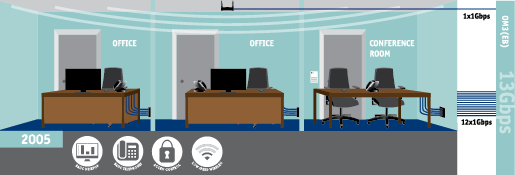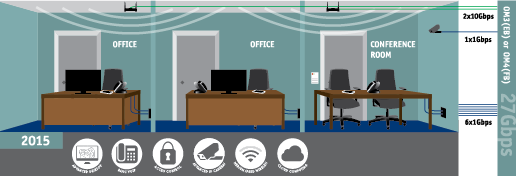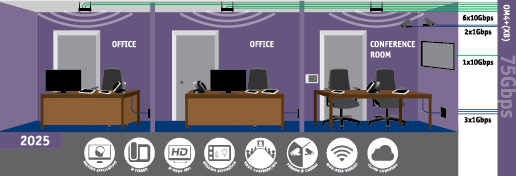Just a few years ago, wireless was considered an optional overlay, a nice-to-have. Today, wireless has evolved from an optional convenience to an expected service. As a result, you’re probably installing fewer 1Gbps network drops to each wall outlet, and many more 10Gbps ceiling drops to support wireless growth. As more and more devices connect to WiFi networks and wireless technology continues to advance, your network will be stressed by additional bandwidth demand not only in the horizontal, but in the fiber backbone as well. Is your network ready?
The building backbone needs to support a 10X transition from 1Gbps wall outlets to 10Gbps ceiling drops.
Several years ago, standard practice was to drop four 1-gigabit-persecond (Gbps) network drops to each wall outlet. Back then, wireless was considered a convenience and it was purely an optional overlay.

Today, we are witnessing fewer 1Gbps network drops to each wall outlet and many more 10Gbps ceiling drops to support wireless growth. Wireless has evolved from an optional convenience, to an expected service.
Moving forward, the ceiling will become digitized with connected sensors to control building automation systems. Additionally, bandwidth demands will ultimately require Wireless Access Point (WAP) density of one WAP per room. Like any medium (fiber, copper, wireless), there is an inverse relationship between bandwidth and reach. WAPs will need to broadcast using higher frequencies (5GHz and beyond), where it becomes more difficult to penetrate walls, doors, and other barriers.
How Will the Next Generation of Wireless Stress Your Network?
Attend this webinar to learn how to minimize the total cost of ownership for your next wi-fi project, how wireless technology is advancing and be prepared for the next generation of wireless!
August 30th, 2017
11:00am EST




.png?width=58&height=58&name=X_logo_2023_(white).png)
